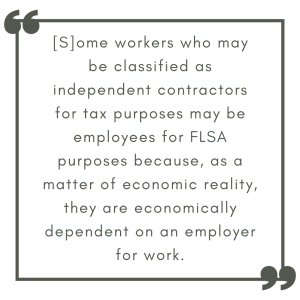Issue 2: Q2 2024

By: Jennifer Carsen
Jennifer is an HR content writer and recovering employment law attorney. Not only is she a member of the Society for Human Resources and the American Society of Journalists and Authors, she was named a “Top 25 Online Influencer in Employment Law” by HR Examiner.
Here’s what you need to know about bringing on employees versus freelancers.
Even in optimal circumstances, hiring a full-time biotech employee is hard. Your team will invariably spend a lot of time and money on recruiting, interviewing, background checks, onboarding, training and so forth.
For many reasons, it’s tempting to consider bringing in an independent contractor instead. It often seems like a cheaper, easier path.
Not so fast.
 Misclassification carries hefty legal risks
Misclassification carries hefty legal risks
Many employers are unaware of the serious risks associated with misclassification—calling someone an independent contractor when they are actually an employee from a legal perspective. (Misclassification can also refer to wrongly determining that a full-time employee is exempt from overtime pay requirements, but that’s the subject of a different article.)
It doesn’t matter if the person would prefer to be an independent contractor, or even if you’ve jointly signed an agreement to that effect. And you don’t get a free pass if the misclassification was an honest mistake. The employee/independent contractor determination is based on complicated—and sometimes inconsistent—lists of factors, and getting it wrong can cost you big.
How big? For starters, you could be responsible for the unpaid employer’s share of the worker’s:
- Income taxes (state and federal)
- Social Security taxes
- Medicare taxes
- Unemployment taxes
You might also be on the hook for:
- Unpaid overtime compensation
- Minimum wage violations
- Late payroll violations
- I-9 violations (because you never completed the new-hire paperwork for an employee)
- The value of unpaid employee benefits, including unemployment, paid leave, and workers’ comp; you may also jeopardize your company’s tax-qualified status under ERISA
- Affordable Care Act violations
- Interest
- Attorney fees
- State law penalties (in California, for example, you could be looking at penalties of $5,000 to $25,000 per willful violation)
- Criminal penalties, if the violation was willful
It can all add up to staggering liability, not to mention reputational damage. You do not want to hit the headlines for this.
Big-ticket payouts
Unfortunately, employers often misclassify multiple workers rather than just one. This quickly ramps up the payouts, as seen in these cases:
- $532,842 in back wages and liquidated damages from a home healthcare business in Montgomery, Alabama, for misclassifying 67 employees as independent contractors
- $650,000 in unpaid overtime wages for 26 delivery drivers in Santa Fe Springs, California
- $1.8 million for 478 misclassified Massachusetts construction workers
- $11 million (in damages, interest and attorney fees) for newspaper carriers misclassified as independent contractors
- $15.5 million to a group of 27 exotic dancers who were intentionally misclassified as independent contractors under Florida law
Different tests abound
What if you’re a well-intentioned employer who’s willing to research and follow the applicable independent contractor rules? That’s easier said than done, as there are numerous state and federal rules, and they are not all consistent with each other.
New FLSA rule
On January 10, 2024, the U.S. Department of Labor (DOL) published a final rule revising DOL guidance on how to analyze employee versus independent contractor status under the federal Fair Labor Standards Act (FLSA).
The rule, which went into effect on March 11, 2024, rescinds a 2021 rule that was perceived as being too likely to lead to a finding of independent contractor status.
According to the DOL, the new rule restores the “economic reality” test, a long-standing multifactor analysis used by courts. It looks at six factors:

- Opportunity for profit or loss depending on managerial skill;
- Investments by the worker and the potential employer;
- Degree of permanence of the work relationship;
- Nature and degree of control;
- Extent to which the work performed is an integral part of the potential employer’s business; and
- Skill and initiative
- The DOL notes that, under this test, no single factor or set of factors is determinative of a worker’s status:
“[T]he economic reality factors are all weighed to assess whether a worker is economically dependent on a potential employer for work, according to the totality of the circumstances.”
Additionally, if a worker satisfies the conditions for being an employee, they are not allowed to waive employee status and choose to be classified as an independent contractor.
While the rule is ostensibly meant to protect workers, many independent contractors are concerned about work drying up because companies will be afraid to contract with them and unwittingly get hit with audits or legal challenges. Several business groups are in the process of challenging the new rule, calling it overly broad and vague.
The bottom line is that the new FLSA rule is designed to—and will—make it more likely that a given worker is deemed an employee rather than an independent contractor.
IRS test
The IRS has its own test for independent contractor status. In 1987, the agency announced what was known as the 20-factor test to evaluate independent contractor status. No single factor was determinative, and the IRS also noted:
“The degree of importance of each factor varies depending on the occupation and the factual context in which the services are performed; factors other than the listed 20 factors may also be relevant.”
More recently, while never explicitly abandoning the 20-factor test, the IRS has turned to a three-category analysis:
- Behavioral: Does the company control, or have the right to control, what the worker does and how the job is done?
- Financial: Are the business aspects of the worker’s job—including things like how the worker is paid, whether expenses are reimbursed, the provision of tools/supplies/etc.—controlled by the employer?
- Type of relationship: Are there written contracts or employee-type benefits such as a pension plan, insurance, vacation pay, etc.? Will the relationship continue and is the work performed a key aspect of the business?
Again, says the IRS, there is no magic bullet:
“Businesses must weigh all these factors when determining whether a worker is an employee or independent contractor. Some factors may indicate that the worker is an employee, while other factors indicate that the worker is an independent contractor. There is no “magic” or set number of factors that “makes” the worker an employee or an independent contractor and no one factor stands alone in making this determination. Also, factors which are relevant in one situation may not be relevant in another.”
NLRB independent contractor standard
In 2023, the National Labor Relations Board (NLRB) returned to a 2014 standard for determining independent contractor status under the National Labor Relations Act (NLRA).
The NLRB now considers “entrepreneurial opportunity” together with traditional common-law factors—those spelled out in court cases. The agency looks at whether the evidence shows that an independent contractor is providing services through their own business.
Much like the new FLSA test, the revised NLRB standard is designed to make a finding of independent contractor status less likely.
Despite this being an NLRB test, you still need to keep it in mind even if you don’t have unionized employees. Many aspects of the NLRA protect the rights of all employees to engage in collective activities regarding the terms and conditions of their work.
State law considerations
Some states have their own tests for independent contractor status that are more stringent than any of the federal tests. California, for example, has used something called the ABC test since 2019.
Under that test, a worker is considered an employee rather than an independent contractor unless the employer is able to show all of the following:
- The worker is free from the control and direction of the hiring entity in connection with the performance of the work, both under the contract for the performance of the work and in fact;
- The worker performs work that is outside the usual course of the hiring entity’s business; and
- The worker is customarily engaged in an independently established trade, occupation or business of the same nature as that involved in the work performed
This is an extremely difficult test for employers to satisfy, as independent contractors must meet all three conditions to avoid being considered employees.
Any time an applicable state-law rule is more protective of workers than the federal standard, the state rule governs. Plus, this determination has gotten more complicated post-COVID as more people work remotely, with some even working from multiple states over the course of a given time period or project.
Conflicting results

Is it possible that a worker is considered an independent contractor under one of these tests and an employee under another? Absolutely, says the DOL:
“[S]ome workers who may be classified as independent contractors for tax purposes may be employees for FLSA purposes because, as a matter of economic reality, they are economically dependent on an employer for work.”
General principles
The common thread among all the tests is that, in general, the more control you exert over a worker in terms of how, where and when the work is done, the more likely that the person will be considered an employee rather than an independent contractor.
Along similar lines, if you hire an independent contractor to do the same job an employee is doing at your company—or even worse, if that same person has previously performed the same or similar work for you as an employee—you’re on legally shaky ground.
There are a few other obvious trouble spots to be aware of:
- Are you the person’s sole source of work/income?
- Is the person’s work and/or schedule closely monitored by someone at your business?
- Is the person’s work central to the core of your business?
- Does the person work on-site?
- Does the person work a full-time schedule for you, or close to it?
- Does the person use a company computer, a company email address, etc.?
- Is the person working on an extensive range of projects rather than something discrete?
- Is the person’s tenure at your company lengthy and/or open-ended?
- Does the person hold themselves out (directly or by implication) as a representative of your company to customers and/or the general public?
All of these are potential red flags that can suggest the person is an employee rather than an independent contractor. But even if you avoid all of them, there is no single determinative factor and no way you can be 100% confident of getting it right.
And even if your worker never complains, the DOL’s Wage & Hour Division can—and does—initiate its own investigations. These are expected to ramp up with the implementation of the new FLSA test this year.
The bottom line is that employers don’t have a lot to go on (or, given the various tests, perhaps too much to go on)—and the consequences of getting it wrong can be devastating.
Don’t go it alone
Despite the various (and conflicting) tests, there are still times when it makes sense to contract with an independent contractor for a small or isolated project.
But, as we hope this piece has made clear, deeming someone an independent contractor rather than an employee to try saving money or to decrease the hiring hassle, is a mistake you don’t want to risk making. When in doubt, the safest course of action is to treat a worker as an employee rather than an independent contractor.
An even better approach is to bring in a partner. You can mitigate most of your risk by hiring a seasoned, well-insured partner to help with your hiring and recruiting. It’s their job to worry about worker status (and get it right) so you don’t have to.








